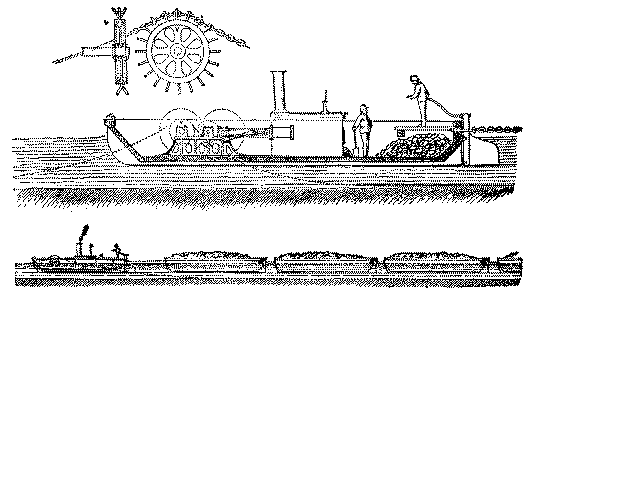and accordingly prepared drawings, with a description of my design, for employing Steam power as the tractive agency for trains of canal barges, in such a manner as to obviate all risk of injury to the banks.

- The scheme consisted in laying a chain along the bottom of the canal, and of passing any part of its length between three grooved and notched pulleys or rollers, made to revolve with suitable velocity by means of a small steam-engine placed in a tug-boat, to the stern of which a train of barges was attached.
NOTE Had this simple means of "tugging" vessels through water-ways been employed in our late attempts to ascend the rapids of the Nile, some very important results might have issued from its adoption.
The steam-engine could thus warp its way along the chain, taking it up between the rollers of the bow of the tug-boat, and dropping it into the water at the stern, so as to leave the chain at the service of the next following tug-boat with its attached train of barges. By this simple mode of employing the power of a steam-engine for canal boat traction, all risk of injury to the banks would be avoided, as the chain and not the water of the canal was the fulcrum or resistance which the steam-engine on the tug-boat operated upon in thus warping its way along the chain; and thus effectually, without slip or other waste of power, dragging along the train of barges attached to the stern of the steam-tug. I had arranged for two separate chains, so as to allow trains of barges to be conveyed along the canal in opposite directions, without interfering with each other.
I submitted a complete set of drawings, and a full description of my design in all its details, to the directors of the Canal Company; and I received a complimentary acknowledgment of them in writing. But such was the prejudice that existed, in consequence of the injury to the canal banks resulting from the use of paddle Wheels, that it extended to the use of steam power in any form, as a substitute for ordinary horse traction; and although I had taken every care to point out the essential difference of my system (as above indicated) by which all such objections were obviated, my design was at length courteously declined, and the old system of horse traction continued.
In 1845 I had the pleasure to see this simple mode of moving vessels along a definite course in most successful action at the ferry across the Hamoaze at Devonport, in which my system of employing the power of a steam-engine on board the ferry boat, to warp its way along a submerged chain lying along the bottom of the channel from side to side of the ferry, was most ably carried out by my late excellent friend, James Rendell, Esq., C.E., and is still, I believe, in daily action, giving every satisfaction.
An Instrument for Measuring the Total and Comparative Expansion of all Solid Bodies.
My kind friend and patron, Professor Leslie, being engaged in some investigations in which it was essential to know the exact comparative total expansion in bulk of metals and other solid bodies, under the same number of degrees of heat, mentioned the subject in the course of conversation. The instrument at that time in use was defective in principle as well as in construction, and the results of its application were untrustworthy. As the Professor had done me the honour to request me to assist him in his experiments, I had the happiness to suggest an arrangement of apparatus which I thought might obviate the sources of error; and, with his approval, I proceeded to put it in operation.
My contrivance consisted of an arrangement by means of which the metal bar or other solid substance, whose total expansion under a given number of degrees of heat had to be measured, was in a manner itself converted into a thermometer. Absolutely equal bulks of each solid were placed inside a metal tube or vessel, and surrounded with an exact equal quantity of water at one and the same normal temperature. A cap or cover, having a suitable length of thermometer tube attached to it, was then screwed down, and the water of the index tube was adjusted to the zero point of the scale attached to it, the whole being at say 50deg of heat, as the normal temperature in each case. The apparatus was then heated up to say 200deg by immersion in water at that temperature. The expansion of the enclosed bar of
| Previous chapter/page | Back | Home | Email this | Search | Discuss | Bookmark | Next chapter/page |